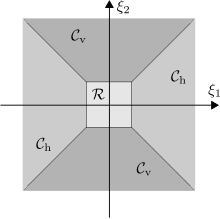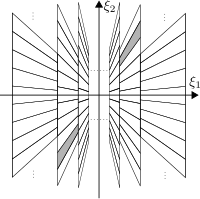此条目需要
精通或熟悉相关主题的编者 参与及协助编辑。
(2015年1月23日 ) 请邀请 适合的人士改善本条目 。更多的细节与详情请参见讨论页 。
在应用数学的分析方面,剪切小波 (英语:Shearlet )是一个多尺度的架构,且在多变量问题中能高效率编码有各向异性 的特点。起初,为了分析及稀疏近似多维方程式
f
∈
L
2
(
R
2
)
{\displaystyle f\in L^{2}(\mathbb {R} ^{2})}
[ 1] 小波分析 的自然延伸,可以适应有各向异性特点的多元方程式,像是影像的轮廓、边缘。然而,各向同性的小波是不能得到此现象。
把抛物线的缩放 、剪切、平移 施加在数个生成函数后可建构出剪切小波。虽然所建构出的剪切小波不能建构出在空间
L
2
(
R
2
)
{\displaystyle L^{2}(\mathbb {R} ^{2})}
正交基底 ,它们仍然可以形成一个架构
剪切小波具有以下几个重要性质:
良好的局部性。它在空间中具有快速的衰减性,在频域内是紧支撑的。
灵敏的方向性。通过一个剪切矩阵来控制方向,随着尺度逐渐精细化,其方向性也会逐渐变得更灵敏。
良好的稀疏逼近性。其逼近率与曲波变换 和轮廓波变换
C
N
−
2
(
log
N
)
3
{\displaystyle CN^{-2}(\log N)^{3}}
[ 2] [ 3]
C
{\displaystyle C}
f
{\displaystyle f}
f
′
{\displaystyle f^{'}}
f
″
{\displaystyle f^{''}}
O
(
N
−
1
)
{\displaystyle O(N^{-1})}
N
{\displaystyle N}
多方辨性。它是由一个或一组函数的缩放平移生成的一个仿射系统,能设计出快速分解重设法。
一致性。能一致处理连续和离散的情况,剪切小波不仅克服了轮廓波和典型小波的不足,也继承了它们的优点。它既能接近最佳的表示一类高维函数,如类卡通图像[ 4] 剪切小波是迄今为止唯一有方向性且提供各向异性特点的稀疏估计的表现系统,可扩展至
L
2
(
R
d
)
,
d
≥
2
{\displaystyle L^{2}(\mathbb {R} ^{d}),d\geq 2}
[ 5]
抛物线缩放和剪切的几何效果,使用一些不同参数a和 s.
连续剪切小波系统的架构是基于抛物线缩放矩阵
A
a
=
[
a
0
0
a
1
/
2
]
,
a
>
0
{\displaystyle A_{a}={\begin{bmatrix}a&0\\0&a^{1/2}\end{bmatrix}},\quad a>0}
为一个改变分辨率的方法。剪切矩阵
S
s
=
[
1
s
0
1
]
,
s
∈
R
{\displaystyle S_{s}={\begin{bmatrix}1&s\\0&1\end{bmatrix}},\quad s\in \mathbb {R} }
为一个改变方向的方法。最后再用平移去改变位置。相较于曲波变换,剪切小波利用剪切的方法取代旋转的方法,其优点在于如果
s
∈
Z
{\displaystyle s\in \mathbb {Z} }
S
s
{\displaystyle S_{s}}
s
∈
Z
{\displaystyle s\in \mathbb {Z} }
x
=
[
x
y
]
,
x
,
y
∈
Z
{\displaystyle \mathbf {x} ={\begin{bmatrix}x\\y\end{bmatrix}},x,y\in \mathbb {Z} }
S
s
x
=
[
x
−
s
y
y
]
∈
Z
2
{\displaystyle S_{s}\mathbf {x} ={\begin{bmatrix}x-sy\\y\end{bmatrix}}\in \mathbb {Z} ^{2}}
结果依然在整数采样点上。[ 5]
给定一个
ψ
∈
L
2
(
R
2
)
{\displaystyle \psi \in L^{2}(\mathbb {R} ^{2})}
ψ
∈
L
2
(
R
2
)
{\displaystyle \psi \in L^{2}(\mathbb {R} ^{2})}
SH
c
o
n
t
(
ψ
)
=
{
ψ
a
,
s
,
t
=
a
3
/
4
ψ
(
S
s
A
a
(
⋅
−
t
)
)
∣
a
>
0
,
s
∈
R
,
t
∈
R
2
}
,
{\displaystyle \operatorname {SH} _{\mathrm {cont} }(\psi )=\{\psi _{a,s,t}=a^{3/4}\psi (S_{s}A_{a}(\cdot -t))\mid a>0,s\in \mathbb {R} ,t\in \mathbb {R} ^{2}\},}
其对应的连续剪切小波转换:
f
↦
S
H
ψ
f
(
a
,
s
,
t
)
=
⟨
f
,
ψ
a
,
s
,
t
⟩
,
f
∈
L
2
(
R
2
)
,
(
a
,
s
,
t
)
∈
R
>
0
×
R
×
R
2
.
{\displaystyle f\mapsto {\mathcal {SH}}_{\psi }f(a,s,t)=\langle f,\psi _{a,s,t}\rangle ,\quad f\in L^{2}(\mathbb {R} ^{2}),\quad (a,s,t)\in \mathbb {R} _{>0}\times \mathbb {R} \times \mathbb {R} ^{2}.}
离散的剪切小波系统可以直接从
SH
c
o
n
t
(
ψ
)
{\displaystyle \operatorname {SH} _{\mathrm {cont} }(\psi )}
R
>
0
×
R
×
R
2
.
{\displaystyle \mathbb {R} _{>0}\times \mathbb {R} \times \mathbb {R} ^{2}.}
{
(
2
j
,
k
,
A
2
j
−
1
S
k
−
1
m
)
∣
j
∈
Z
,
k
∈
Z
,
m
∈
Z
2
}
⊆
R
>
0
×
R
×
R
2
.
{\displaystyle \{(2^{j},k,A_{2^{j}}^{-1}S_{k}^{-1}m)\mid j\in \mathbb {Z} ,k\in \mathbb {Z} ,m\in \mathbb {Z} ^{2}\}\subseteq \mathbb {R} _{>0}\times \mathbb {R} \times \mathbb {R} ^{2}.}
从这个式子,与剪切运算子有关的离散剪切小波系统被定义为:
SH
(
ψ
)
=
{
ψ
j
,
k
,
m
=
2
3
j
/
4
ψ
(
S
k
A
2
j
⋅
−
m
)
∣
j
∈
Z
,
k
∈
Z
,
m
∈
Z
2
}
,
{\displaystyle \operatorname {SH} (\psi )=\{\psi _{j,k,m}=2^{3j/4}\psi (S_{k}A_{2^{j}}\cdot {}-m)\mid j\in \mathbb {Z} ,k\in \mathbb {Z} ,m\in \mathbb {Z} ^{2}\},}
其相关的离散剪切小波转换被定义为:
f
↦
S
H
ψ
f
(
j
,
k
,
m
)
=
⟨
f
,
ψ
j
,
k
,
m
⟩
,
f
∈
L
2
(
R
2
)
,
(
j
,
k
,
m
)
∈
Z
×
Z
×
Z
2
.
{\displaystyle f\mapsto {\mathcal {SH}}_{\psi }f(j,k,m)=\langle f,\psi _{j,k,m}\rangle ,\quad f\in L^{2}(\mathbb {R} ^{2}),\quad (j,k,m)\in \mathbb {Z} \times \mathbb {Z} \times \mathbb {Z} ^{2}.}
设
ψ
1
∈
L
2
(
R
)
{\displaystyle \psi _{1}\in L^{2}(\mathbb {R} )}
∑
j
∈
Z
|
ψ
^
1
(
2
−
j
ξ
)
|
2
=
1
,
for a.e.
ξ
∈
R
,
{\displaystyle \sum _{j\in \mathbb {Z} }|{\hat {\psi }}_{1}(2^{-j}\xi )|^{2}=1,{\text{for a.e. }}\xi \in \mathbb {R} ,}
ψ
^
1
∈
C
∞
(
R
)
{\displaystyle {\hat {\psi }}_{1}\in C^{\infty }(\mathbb {R} )}
supp
ψ
^
1
⊆
[
−
1
2
,
−
1
16
]
∪
[
1
16
,
1
2
]
{\displaystyle \operatorname {supp} {\hat {\psi }}_{1}\subseteq [-{\tfrac {1}{2}},-{\tfrac {1}{16}}]\cup [{\tfrac {1}{16}},{\tfrac {1}{2}}]}
ψ
^
1
{\displaystyle {\hat {\psi }}_{1}}
ψ
1
{\displaystyle \psi _{1}}
傅立叶变换 。例如,可以选择
ψ
1
{\displaystyle \psi _{1}}
ψ
2
∈
L
2
(
R
)
{\displaystyle \psi _{2}\in L^{2}(\mathbb {R} )}
ψ
^
2
∈
C
∞
(
R
)
,
{\displaystyle {\hat {\psi }}_{2}\in C^{\infty }(\mathbb {R} ),}
supp
ψ
^
2
⊆
[
−
1
,
1
]
{\displaystyle \operatorname {supp} {\hat {\psi }}_{2}\subseteq [-1,1]}
∑
k
=
−
1
1
|
ψ
^
2
(
ξ
+
k
)
|
2
=
1
,
for a.e.
ξ
∈
[
−
1
,
1
]
.
{\displaystyle \sum _{k=-1}^{1}|{\hat {\psi }}_{2}(\xi +k)|^{2}=1,{\text{for a.e. }}\xi \in \left[-1,1\right].}
通常会选择一个冲击函数 作为
ψ
^
2
{\displaystyle {\hat {\psi }}_{2}}
ψ
∈
L
2
(
R
2
)
{\displaystyle \psi \in L^{2}(\mathbb {R} ^{2})}
ψ
^
(
ξ
)
=
ψ
^
1
(
ξ
1
)
ψ
^
2
(
ξ
2
ξ
1
)
,
ξ
=
(
ξ
1
,
ξ
2
)
∈
R
2
,
{\displaystyle {\hat {\psi }}(\xi )={\hat {\psi }}_{1}(\xi _{1}){\hat {\psi }}_{2}\left({\tfrac {\xi _{2}}{\xi _{1}}}\right),\quad \xi =(\xi _{1},\xi _{2})\in \mathbb {R} ^{2},}
这被称作一个典型的剪切小波。其对应的离散剪切小波系统
SH
(
ψ
)
{\displaystyle \operatorname {SH} (\psi )}
L
2
(
R
2
)
{\displaystyle L^{2}(\mathbb {R} ^{2})}
[ 5]
另外一个例子是紧支撑的剪切小波系统,其中要选定紧支撑函数
ψ
∈
L
2
(
R
2
)
{\displaystyle \psi \in L^{2}(\mathbb {R} ^{2})}
SH
(
ψ
)
{\displaystyle \operatorname {SH} (\psi )}
L
2
(
R
2
)
{\displaystyle L^{2}(\mathbb {R} ^{2})}
[ 3] [ 6] [ 7] [ 8]
SH
(
ψ
)
{\displaystyle \operatorname {SH} (\psi )}
f
∈
L
2
(
R
2
)
{\displaystyle f\in L^{2}(\mathbb {R} ^{2})}
上述所定义的剪切小波有其缺陷,那就是剪切小波元素的方向性偏差与大的剪切参数有关联。在典型剪切小波的频率拼接(在#范例 中的图可见)中可以看到这个影响,当剪切参数
s
{\displaystyle s}
ξ
2
{\displaystyle \xi _{2}}
ξ
2
{\displaystyle \xi _{2}}
将频域分解成锥形和低频区域 为了解决这个问题,频域被分成一个低频部分和两个锥形部分(如图所示):
R
=
{
(
ξ
1
,
ξ
2
)
∈
R
2
∣
|
ξ
1
|
,
|
ξ
2
|
≤
1
}
,
C
h
=
{
(
ξ
1
,
ξ
2
)
∈
R
2
∣
|
ξ
2
/
ξ
1
|
≤
1
,
|
ξ
1
|
>
1
}
,
C
v
=
{
(
ξ
1
,
ξ
2
)
∈
R
2
∣
|
ξ
1
/
ξ
2
|
≤
1
,
|
ξ
2
|
>
1
}
.
{\displaystyle {\begin{aligned}{\mathcal {R}}&=\left\{(\xi _{1},\xi _{2})\in \mathbb {R} ^{2}\mid |\xi _{1}|,|\xi _{2}|\leq 1\right\},\\{\mathcal {C}}_{\mathrm {h} }&=\left\{(\xi _{1},\xi _{2})\in \mathbb {R} ^{2}\mid |\xi _{2}/\xi _{1}|\leq 1,|\xi _{1}|>1\right\},\\{\mathcal {C}}_{\mathrm {v} }&=\left\{(\xi _{1},\xi _{2})\in \mathbb {R} ^{2}\mid |\xi _{1}/\xi _{2}|\leq 1,|\xi _{2}|>1\right\}.\end{aligned}}}
由典型剪切小波生成的自适应性剪切小波系统的频率拼接 这个自适应性剪切小波系统是由三个部分组成,每个部分都对应到这些频域之一,这个系统是由三个函数
ϕ
,
ψ
,
ψ
~
∈
L
2
(
R
2
)
{\displaystyle \phi ,\psi ,{\tilde {\psi }}\in L^{2}(\mathbb {R} ^{2})}
c
=
(
c
1
,
c
2
)
∈
(
R
>
0
)
2
{\displaystyle c=(c_{1},c_{2})\in (\mathbb {R} _{>0})^{2}}
SH
(
ϕ
,
ψ
,
ψ
~
;
c
)
=
Φ
(
ϕ
;
c
1
)
∪
Ψ
(
ψ
;
c
)
∪
Ψ
~
(
ψ
~
;
c
)
,
{\displaystyle \operatorname {SH} (\phi ,\psi ,{\tilde {\psi }};c)=\Phi (\phi ;c_{1})\cup \Psi (\psi ;c)\cup {\tilde {\Psi }}({\tilde {\psi }};c),}
其中:
Φ
(
ϕ
;
c
1
)
=
{
ϕ
m
=
ϕ
(
⋅
−
c
1
m
)
∣
m
∈
Z
2
}
,
Ψ
(
ψ
;
c
)
=
{
ψ
j
,
k
,
m
=
2
3
j
/
4
ψ
(
S
k
A
2
j
⋅
−
M
c
m
)
∣
j
≥
0
,
|
k
|
≤
⌈
2
j
/
2
⌉
,
m
∈
Z
2
}
,
Ψ
~
(
ψ
~
;
c
)
=
{
ψ
~
j
,
k
,
m
=
2
3
j
/
4
ψ
(
S
~
k
A
~
2
j
⋅
−
M
~
c
m
)
∣
j
≥
0
,
|
k
|
≤
⌈
2
j
/
2
⌉
,
m
∈
Z
2
}
,
{\displaystyle {\begin{aligned}\Phi (\phi ;c_{1})&=\{\phi _{m}=\phi (\cdot {}-c_{1}m)\mid m\in \mathbb {Z} ^{2}\},\\\Psi (\psi ;c)&=\{\psi _{j,k,m}=2^{3j/4}\psi (S_{k}A_{2^{j}}\cdot {}-M_{c}m)\mid j\geq 0,|k|\leq \lceil 2^{j/2}\rceil ,m\in \mathbb {Z} ^{2}\},\\{\tilde {\Psi }}({\tilde {\psi }};c)&=\{{\tilde {\psi }}_{j,k,m}=2^{3j/4}\psi ({\tilde {S}}_{k}{\tilde {A}}_{2^{j}}\cdot {}-{\tilde {M}}_{c}m)\mid j\geq 0,|k|\leq \lceil 2^{j/2}\rceil ,m\in \mathbb {Z} ^{2}\},\end{aligned}}}
式子中的一些变数定义如下;
A
~
a
=
[
a
1
/
2
0
0
a
]
,
a
>
0
,
S
~
s
=
[
1
0
s
1
]
,
s
∈
R
,
M
c
=
[
c
1
0
0
c
2
]
,
and
M
~
c
=
[
c
2
0
0
c
1
]
.
{\displaystyle {\begin{aligned}&{\tilde {A}}_{a}={\begin{bmatrix}a^{1/2}&0\\0&a\end{bmatrix}},\;a>0,\quad {\tilde {S}}_{s}={\begin{bmatrix}1&0\\s&1\end{bmatrix}},\;s\in \mathbb {R} ,\quad M_{c}={\begin{bmatrix}c_{1}&0\\0&c_{2}\end{bmatrix}},\quad {\text{and}}\quad {\tilde {M}}_{c}={\begin{bmatrix}c_{2}&0\\0&c_{1}\end{bmatrix}}.\end{aligned}}}
系统
Ψ
(
ψ
)
{\displaystyle \Psi (\psi )}
Ψ
~
(
ψ
~
)
{\displaystyle {\tilde {\Psi }}({\tilde {\psi }})}
x
1
{\displaystyle x_{1}}
x
2
{\displaystyle x_{2}}
C
h
{\displaystyle {\mathcal {C}}_{\mathrm {h} }}
C
v
{\displaystyle {\mathcal {C}}_{\mathrm {v} }}
ϕ
{\displaystyle \phi }
R
{\displaystyle {\mathcal {R}}}
^ Guo, Kanghui, Gitta Kutyniok, and Demetrio Labate. "Sparse multidimensional representations using anisotropic dilation and shear operators." Wavelets and Splines (Athens, GA, 2005), G. Chen and MJ Lai, eds., Nashboro Press, Nashville, TN (2006): 189–201.
PDF PDF
^ Guo, Kanghui, and Demetrio Labate. "Optimally sparse multidimensional representation using shearlets." SIAM Journal on Mathematical Analysis 39.1 (2007): 298–318.
PDF PDF
^ 3.0 3.1 Kutyniok, Gitta, and Wang-Q Lim. "Compactly supported shearlets are optimally sparse." Journal of Approximation Theory 163.11 (2011): 1564–1589.
PDF PDF
^ Donoho, David Leigh. "Sparse components of images and optimal atomic decompositions." Constructive Approximation 17.3 (2001): 353–382.
PDF PDF
^ 5.0 5.1 5.2 5.3 5.4 Kutyniok, Gitta, and Demetrio Labate, eds. Shearlets: Multiscale analysis for multivariate data . Springer, 2012, ISBN 0-8176-8315-1
^ Kittipoom, Pisamai, Gitta Kutyniok, and Wang-Q Lim. "Construction of compactly supported shearlet frames." Constructive Approximation 35.1 (2012): 21–72.
PDF PDF
^ Kutyniok, Gitta, Jakob Lemvig, and Wang-Q Lim. "Optimally sparse approximations of 3D functions by compactly supported shearlet frames." SIAM Journal on Mathematical Analysis 44.4 (2012): 2962–3017.
PDF PDF
^ Purnendu Banerjee and B. B. Chaudhuri, “Video Text Localization using Wavelet and Shearlet Transforms”, In Proc. SPIE 9021, Document Recognition and Retrieval XXI, 2014 (doi:10.1117/12.2036077).PDF PDF


































![{\displaystyle \operatorname {supp} {\hat {\psi }}_{1}\subseteq [-{\tfrac {1}{2}},-{\tfrac {1}{16}}]\cup [{\tfrac {1}{16}},{\tfrac {1}{2}}]}](https://wikimedia.org/api/rest_v1/media/math/render/svg/b9781e9cfcce51978a270b8e09fc4b00106a90cc)




![{\displaystyle \operatorname {supp} {\hat {\psi }}_{2}\subseteq [-1,1]}](https://wikimedia.org/api/rest_v1/media/math/render/svg/4be9d7048ed3022be72a06f098288a848f9feef6)
![{\displaystyle \sum _{k=-1}^{1}|{\hat {\psi }}_{2}(\xi +k)|^{2}=1,{\text{for a.e. }}\xi \in \left[-1,1\right].}](https://wikimedia.org/api/rest_v1/media/math/render/svg/2fa08b5c6527adfc7cc1f2651b4b413109730f1e)


















